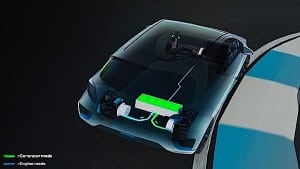
After building hybrids for over a decade, Toyota puts performance with it. Is Toyota reacting to the mounting hybrid competition?
Toyota’s hybrids do one thing well: they are easy on gasoline. If we can say that much about them, we can’t say the same about handling and driving performance. Toyota is a smart and pragmatic company, however. It has enjoyed a few years of making profits with their hybrids, it knows it needs to raise the bar higher. It seems Akio Toyoda, CEO of Toyota, might just succeed in revitalizing the carmaker’s appeal to performance oriented people with the Yaris Hybrid R Concept.
Toyota Hybrid-R Yaris.
Rejoice, Toyota has finally heard us begging for hybrid performance. If it disdains lithium batteries, it is now embracing supercapacitors with its wild Yaris Hybrid-R concept. It will use its ‘Global Race Engine’, the 1.6L engine mated to one electric motor and two others in the back, each rated at 60 HP. The extra 180 HP will help the already potent 300 HP from its gasoline engine push the all-wheel drive Yaris, hair on fire. All of this power will be harnessed by a sequential six-speed gearbox.
Where the Yaris Hybrid-R surprises us is with the judicial use of supercapacitors for its regenerative braking. As you might be aware, regenerative braking uses the loss energy in heat when braking, into electricity by inverting the electric motor’s poles. By feeding those electrons back into the battery pack, you recharge a battery system. Supercapacitors, or ultracapacitors are uniquely well adapted for regenerative braking since they recharge quickly, and discharge as quickly. While they cannot hold a charge too long, they can recoup that loss of energy when braking and help the car accelerate again.
Why is it such a brilliant system? Most active torque vectoring or yaw control rob cars of its power. They essentially slow down a wheel mechanically, by activating the brakes. However, independent electric motors on each wheel can send more, or less power to the wheel to keep the car with the best handling at all times. In the Yaris Hybrid R Concept’s case, the drivetrain goes as far as creating positive or negative torque on demand with the two rear electric motors without robbing power. Instead, it can recharge the supercapacitors by slowing down a wheel in a turn and feeding back that energy later for acceleration. This means the car can use the right amount of energy in any situations, which means serious handling.
The Toyota UK blog hints that it will offer various different driving modes, where the supercapacitor will release energy recovered for a maximum of 20 seconds per charge. At that point, the total power of the two electric motors will be reduced to 40 hp. In track mode, the rear electric motors will put the full 120 HP for up to 5 seconds per charge. This is essentially the KERS system tested in Toyota’s TS030 Hybrid Le Mans racer.
In the last article we wrote on the Yaris Hybrid R Concept, we asked whether or not Toyota was ready to treat us with a hybrid performance version with a resurrected Supra. It sounds it probably is getting ready and the Yaris Hybrid R would serve as a testing ground. Don’t raise your eye brow when you see the words performance and hybrid together. The automobile scene will see many high-performance cars embrace some sort of hybrid solution within the next few years. If Ferrari, MacLaren and Porsche are warming up to the idea, why not Toyota, king of mild mannered hybrids?











